- Details
- Hits: 1317
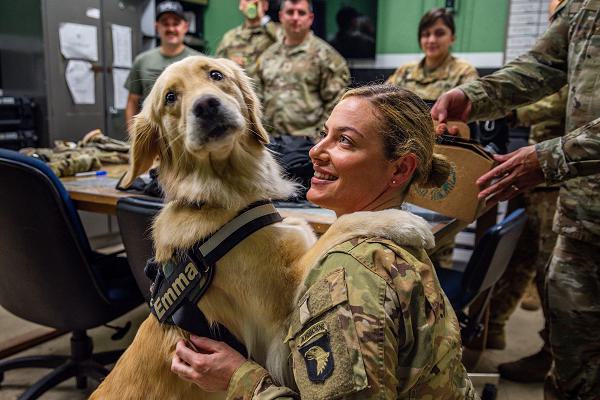
Fort Campbell, Kentucky. (August 16, 2024): These immortal words by the Commander in Chief were in response to the press criticizing him for taking his pet dog on military aircraft. What Truman knew then, and we understand now, is the enormous comfort value service animals bring to the troops. In this photo by Army Specialist Beverly Roche, therapy dog Emma visits soldiers to boost morale and to experience a day in the life of an Apache helicopter pilot. Her mission is to spread smiles to make every day a golden one for our active-duty military.
The use of therapy dogs on military bases has emerged as a vital tool to provide comfort to military personnel. These furry friends offer tremendous emotional support to troops who are grappling with the complex challenges of their duties in the military. These specially trained canines are deployed to active military personnel to help them deal with combat stress, home front issues, and even sleep disorders. Working with combat stress control units, the dogs provide a nonjudgmental presence that helps mental health professionals have more meaningful conversations with troops suffering from Post Traumatic Stress Disorder (PTSD).
For example, nurses stationed at Landstuhl Regional Medical Center in Germany were treated to regular visits from an entire team of therapy dogs that would come to check on the staff of the trauma/intensive care unit. Working in these settings is both physically and emotionally exhausting and the therapy dogs were there to care for the caregivers. In fact, therapy dogs are an essential component used to treat wounded soldiers and active-duty personnel during their journey to recovery at military installations, military and VA medical centers, and VA nursing homes. These dogs are key members of rehabilitation teams working to heal the emotional damage of their patients.
- Details
- Hits: 2178
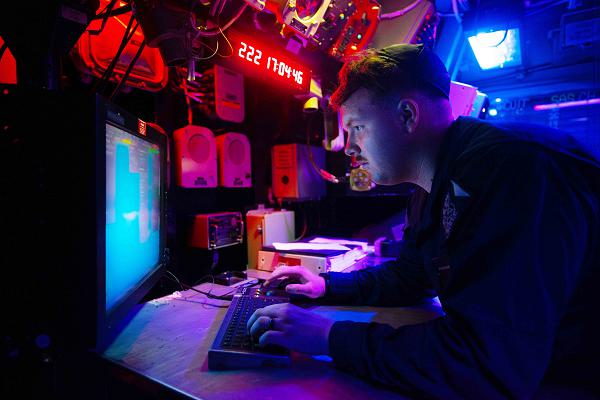
Atlantic Ocean. (August 19, 2024): In ancient times mariners used the stars, dead reckoning, or just plain luck to navigate the seas. Today, America’s warships are guided by a new state-of-the art Voyage Management System developed by the Northrop Grumman Corporation. In this photo by Petty Officer 3rd Class Darren Cordoviz, Navy Petty Officer 2nd Class Brandon Davis tracks the course of the aircraft carrier USS Harry S. Truman during integrated naval warfighting training.
Officially called an Electronic Chart Display and Information System (ECDIS), this new software will become the core navigation tool on the bridge of every U.S. Navy ship and submarine in the next three years. The new ECDIS can process and project multiple chart formats including nautical charts developed by the National Geospatial-Intelligence Agency.
The system tracks targets from the vessel’s navigation radar to create route plans and to monitor progress along the route. Safety checking functions analyze chart data and radar targets to warn of hazards to safe navigation while underway. The platform is modified with a human-machine interface for ease of operator access, improved situational awareness, and increased navigation safety. The system records information such as speeds, heading, fuel consumption, and engine performance.
No longer guided by the stars, today’s Navy is installing the most sophisticated navigation tool ever conceived.
- Details
- Hits: 1642
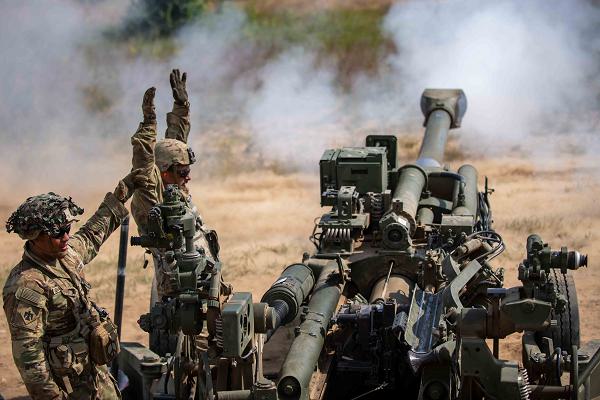
Camp Grayling, Michigan. (August 17, 2024): It is a weapon that can accurately destroy a target up to twenty-five miles away while minimizing the risk to innocent civilians. In this photo by Airman 1st Class Jordaan Kvale, Army Sergeant Jose Ochoa and Specialist Joseph Travino fire a M777A2 howitzer during Exercise Northern Strike 24-2. The British made “triple seven” howitzer has revolutionized artillery warfare in several deadly ways.
First used in combat during the War in Afghanistan, the new howitzer coupled with M982 Excalibur GPS guided munitions have already made history. In June 2012, Golf Battery, 2nd Battalion, 11th Marines successfully fired the triple seven against insurgents at a range of twenty two miles in Helmand Province, Afghanistan. This was the longest operational shot in the history of the M777 howitzer, and the longest operational barrel artillery shot in the history of the Marine Corps.
Excalibur, named after the mythical sword of King Arthur, was developed as a longer-range alternative to conventional artillery shells with GPS guidance added for improved accuracy. Excalibur has a range of approximately 25 to 35 miles depending on the configuration and can strike targets accurately to within sixteen feet. This precision saves lives during close air support of friendly troops while minimizing collateral damage to innocent civilians. Moreover, an Excalibur projectile can accurately hit an intended target that would require the use of between 10 and 50 unguided artillery rounds.
- Details
- Hits: 2634
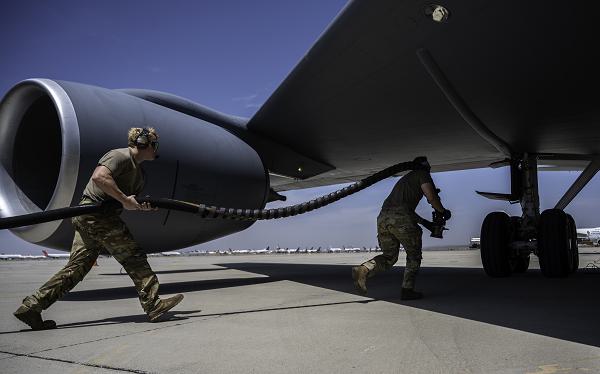
Victorville, California. (August 17, 2024): “Hot-pit refueling” is an extremely dangerous yet essential requirement to keep America’s air fleets in the air. In this photo by Technical Sergeant Alexander Cook, Air Force Staff Sergeant Craig Oliver, left, with the 6th Aircraft Maintenance Squadron and Staff Sergeant Jacob Ebberts, a 52nd Logistics Readiness Squadron petroleum, oils, and lubricants technician, hot-pit refuel a KC-135 Stratotanker.
Hot-pit refueling involves supplying an aircraft with fuel while its engines are running to expedite the turnaround time needed to relaunch the aircraft. In a war, the ability to rapidly refuel airplanes and get them back into the sky is paramount. In the past, an aircraft would typically spend from four to six hours cooling down in a hangar before being refueled. With hot-pit refueling, aircraft can be turned around in sixty minutes or less, which allows the Air Force to generate combat sorties faster.
- Details
- Hits: 1651
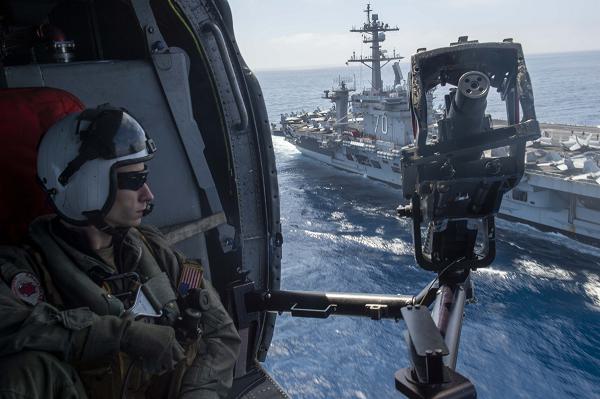
Pacific Ocean. (August 24, 2024): U.S. Navy helicopter crews are like superheroes because they swim, fly, and engage in combat while saving lives. In this photo by Seaman Kenneth Ostas, Naval Aircrewman (Helicopter) 3rd Class Michael Case, from Mountain Home, Arkansas, mans a M3 .50-caliber machine gun aboard a MH-60S Sea Hawk while underway with the Nimitz-class aircraft carrier USS Carl Vinson. Few Navy jobs offer such a range and variety of missions. An Aircrewman can expect to drop off or pick up Navy SEALs, bring supplies to ships at sea, or even jump into the water to save someone’s life. One day they are shooting at enemy planes and the next performing drastic rescues at sea.
Officially called Naval Aircrewman (Helicopter) or AWS for short, these highly skilled professionals perform search and rescue, search for mines from the air, and they insert and extract Special Operations Forces doing dangerous missions. They also fight as aerial gunners, operate radars and sonars, and conduct reconnaissance missions for the fleet. An AWS is an enlisted Sailor who doubles as loadmasters, repair technicians, and is responsible for the safe flight of their assigned aircraft.
Obviously, not everyone can qualify for such a demanding role.
To become an AWS, candidates must pass Basic training and then their thirteen-week A-School at Pensacola, Florida. Next, it is off to Naval Aircrew Candidate School for an additional six weeks of training in water and land survival as well as flight safety. The training is physically tough with topics such as aircrew tasks and assignments, survival, first aid, and water rescue procedures. Candidates must pass a class II swim test, an aviation flight physical, and the Navy Physical Fitness Assessment (PFA) prior to reporting for this demanding aircrew training.
- Details
- Hits: 1027
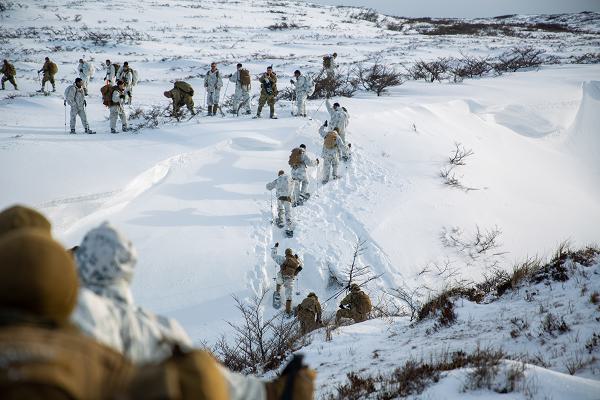
Monte Tarn, Chile. (August 18, 2024): The U.S. Marines joined their Chilean brethren this week to try a little mountaineering in the Andes, the longest mountain range in the world. In this photo by Sergeant Gabriel Groseclose-Durand, Marines with the 1st Marine Division and members of the Cuerpo de Infanteria Marina Chile assess their skills in a freezing weather, high altitude environment. The Marines trained to improve combined task force operations, practice land navigation, and to hone their field craft skills. They certainly chose a tough opponent in the Andes, a mountain range that stretches some 4,400 miles with peaks over 22,000 feet. Throughout the exercise, Marines learned proper techniques for obtaining food and water, employed different weapons and gear, built shelters, practiced foot movements over snow, and performed personnel rescues.
Chile is one of the United States’ strongest partners in Latin America and a leader in promoting respect for the rule of law, economic stability, environmental protection, and human rights. The U.S. supports Chile’s ability to combat terrorism, international crime, drug smuggling, and human trafficking.
Regarded as one of the least corrupt and most vibrant democracies in South America, Chile is a party to the Inter-American Treaty of Reciprocal Assistance, also known as the Rio Treaty. Article three of the Rio Treaty states that “an armed attack on any member is considered an attack on all nineteen signatory countries in the Western Hemisphere. Chile’s law enforcement officials participate in capacity-building programs with the U.S. through the Bureau of Narcotics and Law Enforcement Affairs’ International Law Enforcement Academy. U.S. military assistance strengthens and maintains Chile’s peacekeeping, humanitarian assistance, and disaster response capabilities through equipment purchases, education, and training.
According to several global opinion polls, Chileans have a considerably positive opinion of the U.S. with 72% viewing the U.S. favorably and 62% viewing American influence positively, the highest rating for any surveyed country in Latin America.


